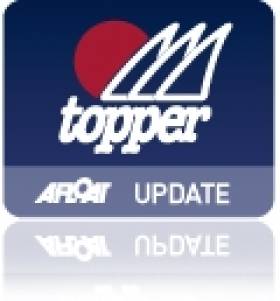Displaying items by tag: Peter Ryan
Peter Ryan of the National Yacht Club is "Sailor of the Month (Services to Sailing)" for December
Peter Ryan of Dun Laoghaire is a dedicated sailing enthusiast – particularly for offshore racing – whose affable exterior camouflages the fact that his brain is busily whirring with ideas for improving the sport. Thus when the challenges of pandemic shutdown arose, he grasped the opportunities provided by being Chairman of the Irish Sea Offshore Racing Association, and having access to a generously donated consignment of Yellowbrick trackers, to set about devising a programme which would comply with regulations while still providing good sport.
It may not have been offshore racing as we know it, as it lacked the post-race parties previously thought indispensable. But it was a proper coastal racing programme nevertheless, with an overall champion (Paul O'Higgins' JPK 10.80 Rockabill VI, RIYC) by the final race in September, while the general ISORA contribution to the legitimate continuation of the sport was also seen in the loan of the Yellowbricks for the excellent Fastnet 450 race in August, and the hugely successful Round Ireland Two-Handed Speed Challenge by Pam Lee of Greystones and Cat Hunt with the Figaro 3 Iarracht Maigeanta in October.
But then Peter Ryan is no stranger to success – he was Commodore of the National Yacht Club in 2011 when it became the Mitsubishi Motors Sailing Club of the Year.
 Responsibility worn lightly - Peter Ryan as Commodore of the National Yacht Club in 2011.
Responsibility worn lightly - Peter Ryan as Commodore of the National Yacht Club in 2011.
'Frustrating But Enjoyable' Isle of Man Offshore Weekend
#isora –Following our post race ISORA report on Monday, Peter Ryan follows up with an indepth report on last weekend's very frustrating, sociable and enjoyable offshore racing weekend.
Race 4, from Holyhead to Douglas, started at 19.20 on Friday evening 22nd May. Race 5 was the return race from Douglas to Dun Laoghaire and started at 06.35 on Sunday 24th May.
To facilitate the setting up of the race on the YB tracker system, the course had to be set on the previous day. At that stage the forecast for the weekend was bleak. Light northerly winds were forecast for the Friday night and moderate south westerly were forecast for the Sunday. This would provide a beat for the full duration of both races. For this reason the Sailing Committee decided to have the course for both races direct from start to finish. Another complication arose for the Friday evening race. The course took the fleet through the traffic separation zone to the north of Holyhead. To avoid any possible dispute about the use or abuse of this zone, the Sailing Committee decided to treat the zone as an "exclusion zone" for the race.
The start of race 4 in Holyhead was not its usual format as works to the pier prevented the usual starter position at the lighthouse been used. Dawn Russell of Holyhead Sailing Club took control of the committee boat and anchored at the opposite end of the line at the Clippera buoy.
18 boats for the entry list of 20 came to the start line. "Mahalar", a new entry from Conwy and "Adelie" headed direct to Douglas and did not take part in the race. All boats taking part were fitted with the recently acquired Avery Crest YB Trackers.
Wind conditions at the start of Race were very light and there was a strong south going tide ripping across the pier end. The boats bunched on the line struggling to get going. "Sgrech" was the first boat to break out west towards fresher winds and headed on its way towards Carmel Rock and the exclusion zone. Soon after, the fleet started moving. "Jackknife" persisted east and this paid off hugely when they shot up the Carmel Rock in a back eddy while the remainder of the fleet plugged the last of the foul tide.
Avoiding the exclusion zone was not a problem for most of the fleet. It kept them bunched. At this stage the tide has turned and the usual Irish Sea north going tide was now flowing east towards Liverpool pulling the fleet in that direction.
The winds during the night were fluky continually coming and going, backing and veering. By day light, most of the fleet had stayed bunched but some had managed to break away. "Aurelia" appeared to have headed west immediately after the exclusion zone despite plugging the east going tide. This paid dividends as he appeared to cruise to the finish line in Douglas while avoiding the huge holes that laid in wait for most of the fleet. "Jackknife" appeared to have missed the holes as well and crossed the finish line after "Aurelia".
Frustration awaited the rest of the fleets as the winds died and the boats were being pushed, first east, then west while looking at the Isle of Man and Douglas. After several hours the sea breeze started to fill and one by one the boats bunched out in the Irish Sea started to peel away and head for the finish.
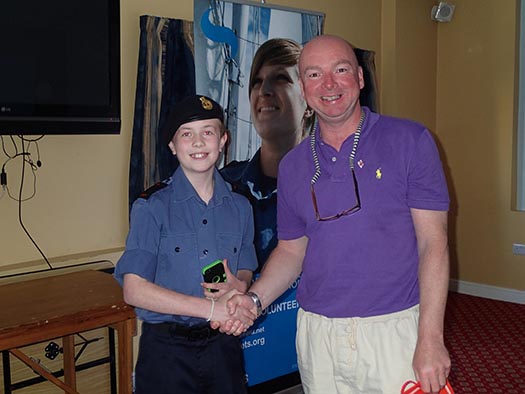
Chris Power-Smith "Aurelia" receives his prize from the Sea Cadets on the Isle of Man
"Aurleia" took Overall and Class 1. Class 2 was taken by our Isle of Man resident, Kuba Szymanski and "Polish manx". Kuba also took Silver Class.
The fleet were met by the Sea Cadets of Isle of Man who distributed a complimentary hot meal to all the crew while they waited on the Visitors Pontoons for the bridge to rise to access the Inner Harbour. The cadets also arranged a BBQ in Douglas Bay Yacht Club that evening. A special prize giving was also arranged by the cadets – the prizes had little to do with racing!!!

The 20–boat ISORA fleet moored up in Douglas
Most of the crew retired reasonably early as the fleet had to vacate the Inner harbour at 05.45 latest on Sunday morning to go to the start for the 06.35 start. A record 22 boats from the 23 entries came to the start. "Mahalar", who was to race had to pull out of the race and generously acted as Committee boat for the start.
The winds were fresh north westerly, up to 20 knots. This was looking like a "drag race" to Dun Laoghaire as the fleet blasted along the IOM coast and head to seas towards Dun Laoghaire with the ebbing tide.
"Jackknife" led the charge with "Lively Lady" behind along the coast. "Aurelia" took the alternative route, taking a more southerly course. Expectations for a fast race were dashed at Lambay island where another hole waited to trap the then weary fleet. "Jackknife", who was just a dot on the horizon for most of the race, started to get "bigger"!!! "Lively Lady", "Ruth" and "Mojito", who were some distance behind the leader, started to slow. The fleet seeing this attempted to circumnavigate the hole by heading out further to sea. All this was fruitless and the fleet stopped. This was not to be a fast race.
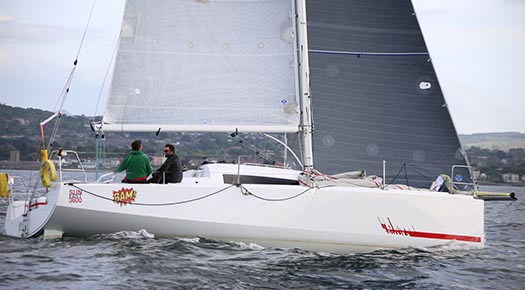
Bam from Howth arrives in Dublin Bay on Sunday evening
Zephyrs eventually started to appear and eventually "Jackknife" broke through the hole and head past Howth head to Dun Laoghaire. "Lively lady" and "Bam" were next to get going and turned into the bay only to smash into what can only be described as a "wind wall"!!! The two boats came to a sudden halt. "Bam" stopped but "Lively Lady", who was close to "Bam" at that stage, managed to keep momentum and broke through the wall. The wind on the other side of the wind wall was from a directly opposite direction.
Most of the fleet did not witness this strange wind effect. However "Sgrech" who was following did, and tried to take the same route as "Lively Lady", but to no avail as they also slammed to a halt beside "Bam". Along came "Ruth" who took a more northerly path around "Bam" and Sgrech" but again slammed into the wall. Next to attempt the wall was "Adelie" – same fate. 2-handed "Jedi " – same fate. When all chances of getting through the wall appeared to have failed, "Mojito" approached the wall and a door opened and they stalled for a brief moment, sails backed onto the opposite side and they dashed off towards the finish line. Very slowly the remaining boats made their way, tacking and gybing, towards the finish.
"Jackknife" took Overall and Class 1 while "Desert Star" took Class 2 and Silver.
All told, it was a very frustrating, sociable and enjoyable offshore racing weekend.
Tsunami Takes Penultimate ISORA Race Win
#isora – This ISORA season was definitely a season of two halves – heavy weather during the first half and very light weather during the second half writes Peter Ryan, ISORA commodore. As so it was for the Race 9 that was originally scheduled to visit the M2 Weather buoy. Traditionally our dominant south westerly winds usually give the desired beat and run but this year was different. North west winds were forecast. Not only that, while there was plenty of wind at the briefing at 08.45, the forecast was to drop to little or nothing at 14.00.
In light of this the Sailing Committee decided that leaving the ISORA fleet bobbing in the middle of the Irish Sea was not to anyone's advantage and re-set the course. The fleet were to head out of Dublin Bay to Bennet Buoy and from there to Taylor's Rock just north of Lambay, leaving Lambay to starboard. The return course was back to Bennet and to the Finish – 38 miles.
With the wind forecast this would produce a beat to Taylor's Rock and a badly needed "J109 knobbling" run back to Bennet. Well it nearly worked out. NYC Commodore, Larry Power sent the fleet of 11 starters reaching off towards Bennet under spinnaker in up to 20 knots of wind at 10:00. The whole fleet soon arrived at it but the wind had started to decrease. "Ruth" was first around followed quickly by "Tsunami", "Axiom" and ""Adelie".
Soon after the entire fleet rounded and were set on the beat to Taylor's Rock the wind dropped and started to back and veer, by up to 50 degrees. With boats back to their number No1's the tactic was to spot the continuous shifts and tack accordingly. The closer the fleet got to Lambay, the more critical this was. "Tsunami" appeared to maximise this and broke away from the fleet rounding Taylor's Rock with a huge lead. "Bag Up" and off they headed to romp home, they thought!!
Very soon after passing the perch at the end of Lambay the North West wind back westerly and then south west before disappearing. "Tsunami" sat in the hole watching the fleet approach them. Hard work by the "Tsunami" crew drove the boat to eventually break through the hole and emerge on the other side into a South Easterly breeze that took them on a beat towards Bennet will the ebbing tide.
The hole in the wind between the north westerly on one side and the south easterly on the other could be clearly seen. It did not move. The following fleet appeared to try and skirt around the hole by heading in towards Howth only to find that the hole extended into the shore!!!
While "Tsunami" beat towards the Bennet in a light breeze, the remainder of the fleet struggled with many retiring at this point. By the time "Tsunami" reached Bennet the tide had just started to head north making the problem for the following boats even greater. At the Bennet ,"Tsunami"'s lead had extended to approximately an hour ahead of "Ruth".
"Tsunami" headed towards the finish in a southerly breeze that got very fickle as they entered into the Bay. Close to the finish the light wind shifted again back to the north west but "Tsunami" was able to cross the line and be greeted by ISORA Finisher, Katheryn Meghan, at 19:06.
Only four boats managed to get to the finish with "Ruth" arriving over two hours after "Tsunami" and the last boat, Pippa IV, crossed the line at 01:23. "Tsunami" took Overall and Class 1 while Pippa IV took Class 2 and Silver Class.
The next race is the last one and takes place on the 6th September – "James Eadie Race" from Pwllheli to Dun Laoghaire. This is always a very popular race and I hope as many boats as possible will support it. There will be the usual Crew Bus to meet the ferry on Friday afternoon in Holyhead and there are plans afoot to have a finishing party in the NYC, if weather permits.
I am pleased to announce that "Hendrick Ryan + Associates", Consulting Structural Engineers, have agreed to sponsor the last race. The title of the race will be the "HR+A James Eadie Race". I am looking for other sponsors of Races and / or Series for next season.
Finally, I have to congratulate our "ISORA brothers" Liam Coyne and Brian Flahive in "Lula Belle" who did extraordinarily well in the recent "Round Britain & Ireland Race". It was some epic feat and I hope that both will share their experiences with us by giving a talk.
National Yacht Club Hosts Offshore Sailing Talk
Sailing offshore? The National Yacht Club is staging an 'Introduction to Offshore Racing' evening next Saturday 7th April 2011 at 19.30 and a line up of speakers inlcudes Maurice 'Prof' O’Connell on winning the 2009 Dun Laoghaire to Dingle Race. Mick Liddy on how to prepare for offshore sailing. Former National Yacht Club commodore Peter Ryan will give tips on ISORA racing in the Irish Sea.
Whether you are a Round Ireland expert or an offshore newbie the Dun Laoghaire club stresses it is an informal night but a 'unique one' both for offshore sailing fans and those who might be considering going offshore for the first time this season.
All the latest ISORA News
All the latest ICRA News
All the latest La Solitaire du Figaro News
All the latest Round Ireland News
National Yacht Club to Stage 2011 Topper Worlds
The 2011 Topper World Championships will be hosted by the National Yacht Club in Dun Laoghaire.
The club beating off stiff competition from around Europe to secure this major sailing event. It follows the successful 2010 Topper Worlds held at Lake Garda last August. The news was confirmed by Bill Brassington, President, International Topper Class Association.
Over 250 of the world's top youth sailors are expected to partake in the Irish event which will run from August 15th - 19th 2011 and promises some of the closest and most exciting youth sailing ever seen on Dublin Bay.
The Topper is one of the world's most popular youth boats with over 50,000 boats around the globe. It has grown greatly in popularity in recent years because it suits the learner sailor as well as those with ambitions of Olympic medals. Because it is exceptionally light and easy to transports the National Yacht Club are expecting 150 competitors from other countries to partake.
National Yacht Club Commodore Peter Ryan commented on the announcement: "We are delighted to be hosting the Topper World Championships next August. It will follow on from the Figaro Race stop over and reflects that fact that Dublin Bay can cater for top class events for both ends of the spectrum. The Topper is an extremely popular boat with young sailors and a great gateway to sailing so we will be putting all the club resources into making the event an outstanding success."
The Topper was designed by Ian Proctor whose other boats include the ever popular Wayfarer. It was originally constructed in GRP but this was changed quite early on to an injection moulding construction. After well over 20 years of continuous production it is the outstanding build quality, durability and innovative design features that have made the Topper a very popular boat. The Topper hull is injection moulded with incredible precision, reaching a level of uniformity quite outside the scope of any other production system, either hand built or mass produced in GRP or roto-moulded plastic. The material is polypropylene which has proved to combine strength and flexibility with lightness and virtually everlasting life.
Black Tie Finale to ISORA Season
Irish Sea Offshore sailing Chief Peter Ryan has circulated the Notice and Agenda for next Saturday's ISORA AGM at the National Yacht Club and told Ireland's biggest band of offshore crews to wear dinner jackets so they can vote on next year's sailing, watch Ireland play South Africa and attend the formal ISORA prize giving dinner all at the same waterfront venue.
The AGM takes place at 14.00 at the NYC. The rugby match is on at 17.30 and Ryan says if sailors are interested they can dress up in your tux and watch the match.
Immediately after the match at 19.45, the pre-dinner drinks reception will be held in the JB Room of the Dun Laoghaire club with complimentary sparkling wine and classical music by the Neptune Trio.
Dinner will be at 20.30 sharp to enable the prize giving to take place at 22.00 and finish of ceremonies by 23.00 latest. After this sailors can relax or dance the night away at the ISORA disco.
AGM papers are attached for download.
2011 ISORA Scoring and Race Programme Up for Debate
The first is a proposed race schedule for 2011. Due to the number of races and the large variation in the distance and complexity, Ryan is proposing to identify some of the main races as those that qualify for the Overall ISORA Series - "The Wolf's Head Trophy". The other races will qualify for another lesser series that involves all races. Trophies and prizes will be awarded for all races irrespective of status.
The second issue is the proposed use of the High Score system and incorporating a difficulty coefficient to reflect the type of race involved. The use of the high scoring system will also be preferable when dealing with a series where many boats will not do most of the races and the variation in the fleet numbers can be significant.
Stephen Tudor of PSC has used the results from 2010 to illustrate the proposed system and these are attached below. Unfortunately (or fortunately) in the example the places of the top boats are generally unaltered but this is due to the fact that the top boats did most or all the races.
Ryan also says he has contacted RORC and they have agreed in principle to accept any ISORA race of over 75 miles and incorporating a night passage as a qualifier for next year's Fastnet Race.
The main purpose of the exercise is to encourage boats to do as many of the races as possible but not the penalise them too much for races missed. It is also to reward those boats more that win in large fleets over a win in a smaller fleets. Day races will be used to encourage and entice more new entries to ISORA in 2011.
The Race Schedule and Scoring System will be agreed at the AGM.
Offshore Boss to Address ICRA Conference
Irish Sea Offshore Racing (ISORA) Chairman Peter Ryan is to address next month's Irish Cruiser Racer (ICRA) conference in Carrigaline, Co.Cork. The National YC commodore will speak on the promotion of offshore racing and how in the course of a few seasons Ryan has rekindled a section of the sport that had been in decline on both sides of the Irish Sea.
The Conference takes place on Saturday, November 13th at Carrigaline Court Hotel. The day-long conference chaired by Commodore Barry Rose with two sessions 11-1 and 2-4pm will take in all aspects of cruiser racing including how Ireland won this year's Commodores Cup. A special event is being arranged to mark the Cup coming to Ireland for the first time.
Overall ISORA Honours will be Determined by September Race
In an exciting sailing climax for a buoyant ISORA series September's race will determine the overall winner. “Raging Bull”, “Just Enough” and the reigning Champion, “Tsunami” can all take the Wolf’s Head Trophy. Peter Ryan reports on this and news from last weekend's race 8, the M2 buoy race.
The series table is available to download below.
From an entry list of 30 boats, 17 boats came to the line in Dun Laoghaire for the 8th ISORA race. We had one new boat taking part in this race, “Oystercatcher”. The course for the night was: Start – M2 Weather Buoy (P) –Finish.
The forecast for the race looked perfect – 10-12 kts South west. It was expected that the fleet would complete the 54-mile course with no problem. However, as usual, this is not what happened!!! While all boats completed the course, the winds were far from perfect.
The race was started by Peter Beamish, Commodore of the Royal Alfred Yacht Club and Paul McCarthy. The wind at the start was 16kts – south west. This gave a dead run to the M2. The fleet started off the line with spinnakers. As the course was a dead run, the fleet broke into two gybes. Twelve boats heading north towards Howth head while five boats heading out towards Kish. All of a sudden a big hole appeared around the five boats and sat closely by for over a hour while the north fleet headed over the horizon. It was not until the north fleet was a dot on the horizon did the wind fill in and the five boats headed off towards M2. The wind had backed making the leg a broad reach. The wind also increased to 23 knots as the fleet approached M2.
“Roller Coaster” was the first to round M2 with the remainder of the fleet following in procession. It seemed like the return leg would be a simple fetch back to Dun Loaghaire. However, the wind was having none of this. There were several massive wind shifts and wind speed variations all through the leg. Shifts in the order of 60 degrees were experienced as the fleet got into Dublin Bay.
“Roller Coaster” took line honours, 1st Overall and 1st in Class 1. “Team Windmill” took 2nd Overall and 2nd Class1. “Raging Bull” took 3rd Class 1. “Big Hillie Style” took 1st Class 2 and 3rd Overall. Newcomer “Oystercatcher” took 2nd in Class 2 while “Just Enough” took 3rd Class 2.
The next race is on the 11th September, the James Eadie Race from Pwllheli to Howth. The Overall ISORA Championship will be determined by the outcome of this race. “Raging Bull”, “Just Enough” and the reigning Champion, “Tsunami” can all take the Wolf’s Head Trophy.



























